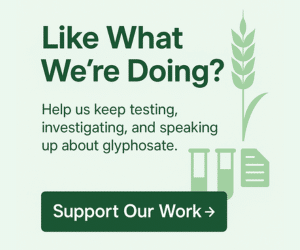You’ve seen our honey test results.
Trace amounts of glyphosate — the active ingredient in weedkillers like Roundup — are turning up in honey pots up and down the country. From boutique producers to household brands, the chemical is showing up in a food we’ve long thought of as pure, natural, and untouched.
But here’s the head-scratcher: if glyphosate is toxic to bees, how are the hives still standing? Why aren’t beekeepers sounding the alarm about mass die-offs?
Let’s walk through it.
“Avoid Spraying When Bees Are Foraging” — But What Happens Next?
Many herbicide labels, including some glyphosate-based weedkillers like Roundup, carry general advice to avoid spraying when bees are actively foraging. Fresh glyphosate droplets can be deadly if a bee comes into direct contact — whether it lands on a wet, sprayed surface or is hit by a droplet while foraging.
The thing is, bees don’t work set hours. They’re out whenever the weather’s right.
So what if spraying happens when they’re back in the hive? The droplets dry, the plants may look untouched, but the chemical residue remains… but the glyphosate doesn’t just vanish. It lingers on leaves, stems, and flowers in residue form — ready to be collected and carried back to the hive in nectar and pollen.
The Bee’s Big World
A single bee can travel up to 1.5 kilometres from its hive — nearly 700 hectares. Think about what fits into that circle: farmland, roadside verges, parks, orchards, gardens. Even if a beekeeper never touches glyphosate, their bees can wander into plenty of places where it’s been sprayed.
Now here’s the important bit: dried glyphosate residue usually won’t kill a bee outright. The dose is too small for that. But “too small to kill” is not the same as harmless.
Traces Travel Home
Bees bring back nectar and pollen from wherever they’ve been. If they visited sprayed plants, trace glyphosate comes with it.
In the hive:
- Nectar becomes honey
- Pollen becomes bee bread (protein for the colony)
- The wax comb itself can absorb residues
It’s not like the bees know they’re delivering a chemical stowaway. They’re just doing their job.
So Why Aren’t the Hives Dropping Dead?
Acute bee deaths happen when the dose is high — think direct contact with fresh spray.
The glyphosate levels we’re finding in honey are measured in parts per billion (ppb) — a whisper of a dose. Enough to measure in the lab, enough to show up in your food… but not enough to cause an immediate collapse.
Instead, scientists talk about sublethal effects. Low-level glyphosate exposure can:
- Mess with a bee’s gut microbiome (weakening digestion and immunity)
- Disrupt navigation (so they can’t find their way back as well)
- Slow the development of young bees
The colony survives, but it’s under subtle, chronic stress. And when you add in other pressures — varroa mites, habitat loss, poor nutrition — it’s like death by a thousand cuts.
We’ve written more about this in our piece on Glyphosate’s Impact on Bees and how it can even disrupt their brain function and navigation.
From Hive to Human
By the time the honey’s harvested, spun out, and jarred, those trace glyphosate molecules are still in there.
Our tests have found between 2 ppb and 12 ppb in honey sold across New Zealand — from supermarket shelves to specialty stores and online sellers. That’s not going to kill you instantly (or a bee), but it’s not zero either.
And if it’s in honey — one of the most “natural” foods we produce — it’s a sign of something bigger: glyphosate is now so embedded in our landscapes that not even the bees can dodge it.
Some beekeepers shrug and say glyphosate is “everywhere” — and in a way, they’re right. Bees can visit hundreds of flowers across farmland, road verges, and gardens in a single trip, picking up residues sprayed days earlier.
But here’s the flaw in that thinking: just because something is widespread doesn’t make it harmless. Arsenic and lead used to be “everywhere” too. Normalising contamination isn’t the same as proving safety — it just shifts the baseline of what we’re willing to accept.
In fact, we’ve heard first-hand accounts of hive collapses linked to glyphosate spraying. In our article Glyphosate Survivor Testimony, Liz recalls watching a local beekeeper’s hives collapse after spraying:
“The bees flew to their deaths, landing lifeless outside my bedroom window. I’ll never forget it.”
The Bigger Question
This isn’t about blaming beekeepers. It’s about asking: do we want to keep using a chemical so pervasively that it slips into the food chain — unnoticed, unlabelled, and uninvited — even in the products we pride ourselves on being pure?
Resources & References
The story of glyphosate in honey isn’t just about beekeeping — it’s about how a chemical designed to kill plants can linger in the landscape, make its way into the hive, and end up in a jar without killing the bees that gathered it. The resources below dig deeper into the science, the environmental pathways, and the unanswered questions about what happens long after the spray nozzle clicks off.
International Agency for Research on Cancer (IARC) – Glyphosate Monograph
The 2015 assessment classifies glyphosate as “probably carcinogenic to humans” (Group 2A), summarizing key evidence from animal studies and mechanistic data.
Codex Alimentarius – Honey Standard (CXS 12-1981)
The international benchmark for honey composition and safety. It forms the basis for many country-level regulations, including MRLs.
MPI – Glyphosate in Food (Food Safety NZ)
Information from New Zealand’s Ministry for Primary Industries on glyphosate residue limits, monitoring practices, and how they apply to different food categories.
Analytica Laboratories – Glyphosate Residues in Honey
An industry perspective on testing thresholds and analytical methods used for detecting glyphosate in honey.
Whitewash: The Story of a Weed Killer, Cancer, and the Corruption of Science
By Carey Gillam (2017)
A critical investigation into the history of glyphosate, controversies over its safety, and how scientific research has been influenced by industry interests.
Understanding these pathways is key to changing them. The more we learn about how glyphosate moves through the environment — and how it interacts with pollinators, plants, and people — the harder it becomes to accept its presence as “just the way things are.” These links aren’t the end of the conversation, but an invitation to keep asking questions and looking closer.
Image Source & Attribution
We’re grateful to the talented photographers and designers whose work enhances our content. The feature image on this page is by Furian.




